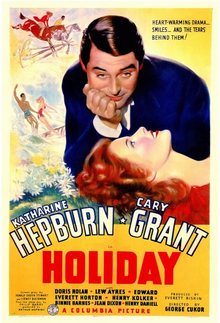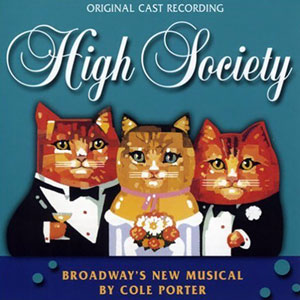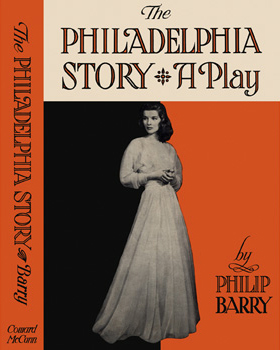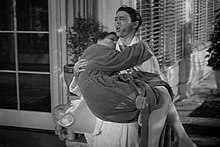
George Dewey Cukor was an American film director and producer. He mainly concentrated on comedies and literary adaptations. His career flourished at RKO when David O. Selznick, the studio's Head of Production, assigned Cukor to direct several of RKO's major films, including What Price Hollywood? (1932), A Bill of Divorcement (1932), Our Betters (1933), and Little Women (1933). When Selznick moved to Metro-Goldwyn-Mayer in 1933, Cukor followed and directed Dinner at Eight (1933) and David Copperfield (1935) for Selznick, and Romeo and Juliet (1936) and Camille (1936) for Irving Thalberg.

Cary Grant was an English-American actor. He was known for his Mid-Atlantic accent, debonair demeanor, lighthearted approach to acting, and sense of comic timing. He was one of classic Hollywood's definitive leading men. He was nominated twice for the Academy Award, received an Academy Honorary Award in 1970, and received the Kennedy Center Honor in 1981. He was named the second greatest male star of the Golden Age of Hollywood by the American Film Institute in 1999.

Katharine Houghton Hepburn was an American actress whose career as a Hollywood leading lady spanned six decades. She was known for her headstrong independence, spirited personality, and outspokenness, cultivating a screen persona that matched this public image, and regularly playing strong-willed, sophisticated women. She worked in a varied range of genres, from screwball comedy to literary drama, and earned her various accolades, including four Academy Awards for Best Actress—a record for any performer. In 1999, Hepburn was named the greatest female star of classic Hollywood cinema by the American Film Institute.

Spencer Bonaventure Tracy was an American actor. He was known for his natural performing style and versatility. One of the major stars of Hollywood's Golden Age, Tracy was the first actor to win two consecutive Academy Awards for Best Actor, from nine nominations. During his career, he appeared in 75 films and developed a reputation among his peers as one of the screen's greatest actors. In 1999, the American Film Institute ranked Tracy as the 9th greatest male star of Classic Hollywood Cinema.

Adam's Rib is a 1949 American romantic comedy-drama film directed by George Cukor from a screenplay written by Ruth Gordon and Garson Kanin. It stars Spencer Tracy and Katharine Hepburn as married lawyers who come to oppose each other in court. Judy Holliday co-stars as the third lead in her second credited movie role. Also featured are Tom Ewell, David Wayne, and Jean Hagen. The music was composed by Miklós Rózsa, and the song "Farewell, Amanda" was written by Cole Porter.

Bringing Up Baby is a 1938 American screwball comedy film directed by Howard Hawks, and starring Katharine Hepburn and Cary Grant. It was released by RKO Radio Pictures. The film tells the story of a paleontologist in a number of predicaments involving a scatterbrained heiress and a leopard named Baby. The screenplay was adapted by Dudley Nichols and Hagar Wilde from a short story by Wilde which originally appeared in Collier's Weekly magazine on April 10, 1937.

Woman of the Year is a 1942 American romantic comedy-drama film directed by George Stevens and starring Spencer Tracy and Katharine Hepburn. The film was written by Ring Lardner Jr. and Michael Kanin, and produced by Joseph L. Mankiewicz.

Father of the Bride is a 1950 American romantic comedy film directed by Vincente Minnelli from a screenplay by Frances Goodrich and Albert Hackett, based on the 1949 novel of the same name by Edward Streeter. The film stars Spencer Tracy, Joan Bennett, and Elizabeth Taylor, and follows a man trying to cope with preparations for his daughter's wedding. Father of the Bride was nominated for Academy Awards for Best Picture, Best Writing, Screenplay, and Best Actor in a Leading Role.

Edward, My Son is a 1949 British drama film directed by George Cukor for MGM-British Studios that stars Spencer Tracy and Deborah Kerr. The screenplay by Donald Ogden Stewart is based on the 1947 play of the same title by Noel Langley and Robert Morley.

High Society is a 1956 American musical romantic comedy film directed by Charles Walters and starring Bing Crosby, Grace Kelly, and Frank Sinatra. The film was produced by Sol C. Siegel for Metro-Goldwyn-Mayer, and shot in VistaVision and Technicolor, with music and lyrics by Cole Porter.

Garson Kanin was an American writer and director of plays and films.

Sylvia Scarlett is a 1935 American romantic comedy film starring Katharine Hepburn and Cary Grant, based on The Early Life and Adventures of Sylvia Scarlett, a 1918 novel by Compton MacKenzie. Directed by George Cukor, it was notorious as one of the most famous unsuccessful movies of the 1930s. Hepburn plays the title role of Sylvia Scarlett, a female con artist masquerading as a boy to escape the police. The success of the subterfuge is in large part due to the transformation of Hepburn by RKO makeup artist Mel Berns.

Pat and Mike is a 1952 American romantic comedy film starring Spencer Tracy and Katharine Hepburn. The movie was written by Ruth Gordon and Garson Kanin, and directed by George Cukor. Cukor directed The Philadelphia Story (1940) with Hepburn, and Cukor, Gordon and Kanin teamed with Hepburn and Tracy again for Adam's Rib (1949). Gordon and Kanin were nominated for the 1952 Academy Award for Best Original Screenplay for their work on Pat and Mike.

Holiday is a 1938 American romantic comedy film directed by George Cukor, a remake of the 1930 film of the same name.

Keeper of the Flame is a 1942 American drama film directed by George Cukor, and starring Spencer Tracy and Katharine Hepburn, released by Metro-Goldwyn-Mayer (MGM). The screenplay by Donald Ogden Stewart is adapted from the 1942 novel Keeper of the Flame by I. A. R. Wylie. Hepburn plays the widow of a famous civic leader who has died in an accident. Tracy portrays a former war correspondent who intends to write a flattering biography of the dead man, only to find that his death is shrouded in mystery. Screenwriter Stewart considered the script the finest moment of his career, feeling vindicated by the assignment as he believed that Hollywood had punished him for years for his political views. Principal filming began in the last week of August 1942, four months after the release of the novel, published by Random House. The picture was filmed on a sound stage, with no location shooting. Hepburn had already begun a relationship with Tracy, and his heavy drinking led her to become his vigilant guardian during the filming.
The comedy of remarriage is a subgenre of American comedy films of the 1930s and 1940s. At the time, the Production Code, also known as the Hays Code, banned any explicit references to or attempts to justify adultery and illicit sex. The comedy of remarriage with the same spouse enabled filmmakers to evade this provision of the Code. The protagonists divorced, flirted, or even had relationships, with strangers without risking the wrath of censorship, and then got back together.

High Society is a musical comedy with a book by Arthur Kopit and music and lyrics by Cole Porter. Some updated or new lyrics were provided by Susan Birkenhead. The musical is based on Philip Barry's 1939 stage comedy The Philadelphia Story and the subsequent 1956 musical film adaptation, High Society, which features Porter's songs. The musical includes most of the music featured in the movie, along with several songs selected from other Porter musicals. It premiered on Broadway in 1998 and has since been revived. Another musical adaptation of the story had opened in London in 1987 with a different book by Richard Eyre.

Without Love is a 1945 romantic comedy film directed by Harold S. Bucquet and starring Spencer Tracy, Katharine Hepburn, and Lucille Ball. Based on a 1942 play by Philip Barry, the film's screenplay was written by Donald Ogden Stewart.

The Philadelphia Story is a 1939 American comic play by Philip Barry. It tells the story of a socialite whose wedding plans are complicated by the simultaneous arrival of her ex-husband and an attractive journalist. Written as a vehicle for Katharine Hepburn, its success marked a reversal of fortunes for the actress, who was one of the film stars deemed "box office poison" in 1938.

Holiday is a 1928 play by Philip Barry which was twice adapted to film. The original play opened in New York on November 26, 1928, at the Plymouth Theatre and closed in June 1929, after 229 performances. It was directed by Arthur Hopkins, set design by Robert Edmond Jones, and costume design by Margaret Pemberton.






















